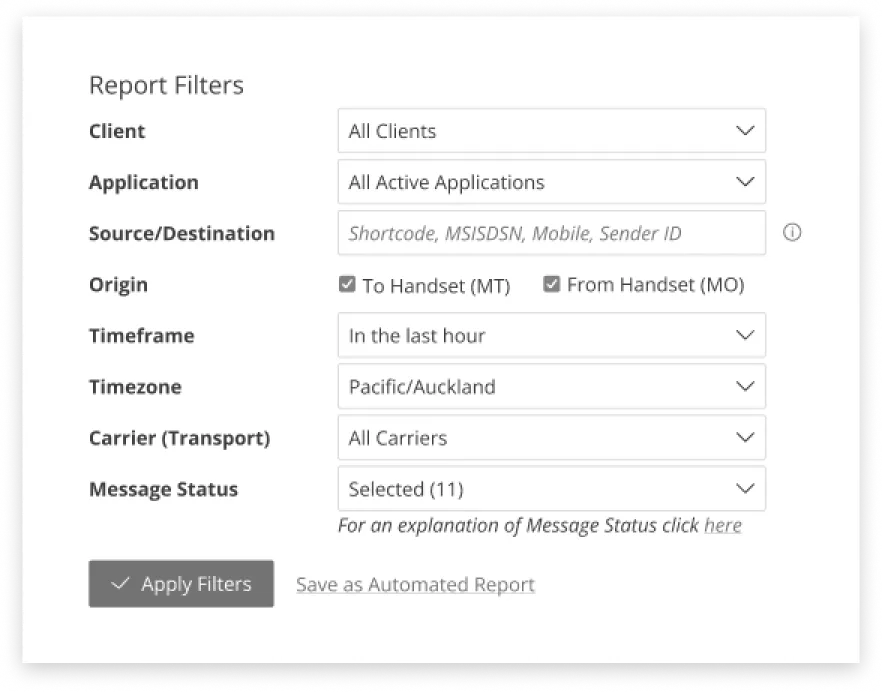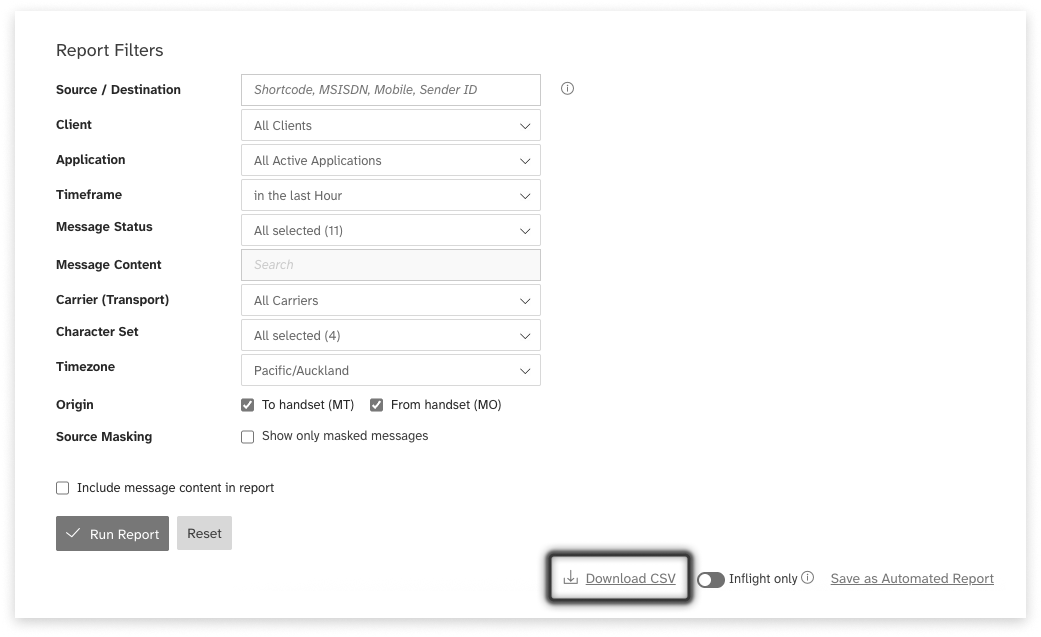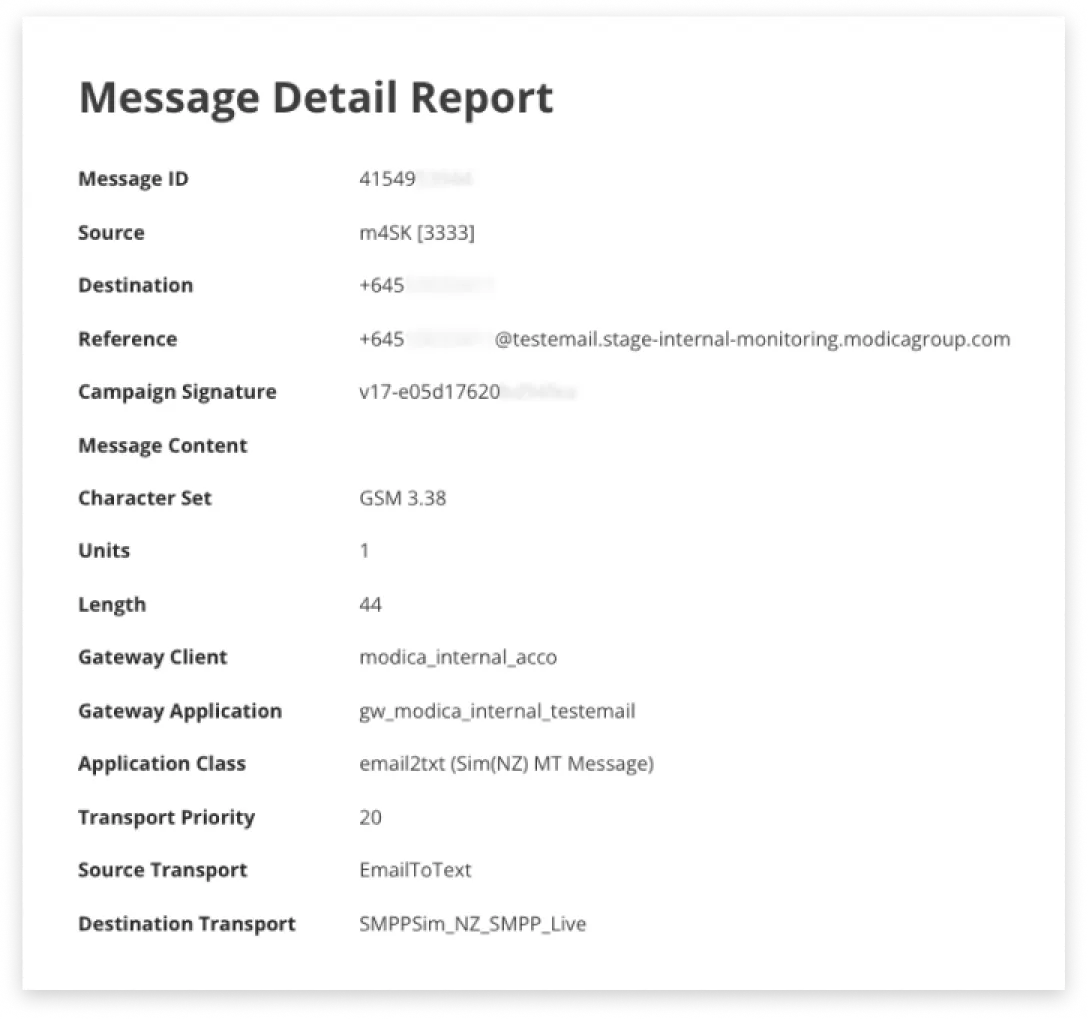Mobile Report
Mobile Report offers a detailed overview of all traffic processed by our platform. It includes specific information about each transaction (such as timestamps and status changes) for the purpose of audit, troubleshooting, and analysis.
Mobile Report can be accessed from the side menu, under Data & Insights.
Individual Message Details
- Search Message ID: search for unique Message ID, which are automatically assigned to each message

Report Filters
-
Client: view messages by Client name
-
Application: sort messages by the gateway applications a message was sent or received via
-
Source/Destination: search for a message by original source, or destination
- Shortcode - a shortened phone number, e.g. 1234
- MSISDN or Mobile - a full phone number, e.g. +15 555 1234
- Sender ID - a label that masks sending details, e.g. Brand Name
-
Origin: filter messages by their point of origin -
- MT = (Mobile Terminated) originated elsewhere, finished at a mobile handset
- MO = (Mobile Originated) originated from a mobile handset
-
Timeframe: filter by when the message was first sent
-
Timezone: set your preferred time zone for viewing data
-
Carrier (Transport): identify the mobile network used for message delivery
-
Message Status: filter messages based on sending statuses
-
Character Set: filter messages based on the character encoding used. Not all have access to this

Mobile Report Table
-
Message ID: an automatically created unique ID. Click the Message ID to view a detailed report about this message
-
Date/Time: when a message was date-and-time-stamped as Queued for sending (the first message sending Status)
-
Application: the gateway Applications messages were sent or received via
-
Origin: MO messages originated from a mobile handset. MT messages were sent to a handset and terminated there
-
Source: the short code, long code, MSISDN or Sender ID / mask a message was sent from
-
Destination: the short code, long code, or MSISDN a message was sent to
-
Message Status: all statuses that a message passed during sending, with a date and time stamp
-
Units: the number of units sent per message. When the character limit of a unit has been exceeded, a second unit is sent as a message
-
Transport: the mobile network used for delivery
-
Content: content of the message. This is not always visible to all.

Download Mobile Report
Users with access to Mobile Report can download the search results into a CSV file for further analysis.

Please note that only users with access to view and download message content will be able to see this data in the downloaded report.
We encourage organisations and users to follow your organisational policies and processes for downloading content that may contain personally identifiable information (PII) or other sensitive information.
Message Detail Report
Use this report to analyse message delivery, troubleshoot issues related to delivery or content, and ensure compliance with messaging regulations.
Report Fields
-
Message ID: the unique identifier of this message
-
Source: origin of the message - could be a short code, long code, MSISDN or Sender ID / mask
-
Destination: recipient of the message - can be a short code, long code, or MSISDN
-
Reference: if a message was delivered or received via an API, the provided reference value is displayed here
-
Campaign Signature: a unique reference number grouping messages sent as a campaign
-
Content: message content; not always universally visible (permission based)
-
Character Set: character encoding indicator
-
Units: number of units sent per message; exceeding the character limit creates concatenated messages
-
Length: total character count in the message content
-
Gateway Client: gateway account that initiated or received the message
-
Gateway Application: gateway Application used for sending or receiving messages
-
Application Class: the application used to send or receive messages from different origins (MO or MT)
-
Transport Priority: the priority of the route used during message sending
-
Source Transport: Gateway Transport used to dispatch messages for delivery
-
Destination Transport: mobile network that receives the message for delivery to the recipient

Delivery Logs
-
Date/Time: a timestamp relating to the message status
-
Message Status: listed from first to last status; all messages start their journey by being Queued
-
Status Message: greater detail on each message status - can include an error code for platform troubleshooting

Message Statuses
As a message progresses through our system it is given an updated status, each of which is timestamped for accurate tracking.
Successful Delivery
Messages are passed through a chain to reach their destination, and their statuses represent each point of the journey.
To Mobile Handsets (MT)
The perfect message will show Queued > Sent > Submitted > Received.
-
Queued: still to be passed from our platform to the network carrier
-
Sent: passed to the network carrier for delivery
-
Submitted: submitted by the carrier for delivery to the recipient’s mobile handset
-
Received: received and receipted by the recipient’s handset
-
Read: this status is only available to selected non-SMS channels (e.g. WhatsApp or email). Not available for SMS
From Mobile handsets (MO)
-
Queued: Our platform received the message from a carrier and has routed it to an Application
-
Sent: Our platform has completed the callback request to the configured application or MO callback URL
Still-Processing
-
Diverted: A message is waiting to be sent but is being held in a queue, due to a pause in your account’s processing. This pause is set using our Sending Hours tool.
-
Pending: The carrier acknowledged getting the message from our platform, but hasn’t delivered it to the handset yet
- If the carrier can’t deliver the message (phone off, out of range, or load issues on their network), the message can stay Pending for some time.
- Each carrier has their own rules for retrying messages. Some will return Frozen or Expired statuses, some will not.
Not Delivered
-
Failed: Messages that have failed to leave our platform
- This can be caused by attempting to send to numbers that have ‘opted out’ of previous campaigns, invalid formatting, or a connectivity or system issue.
-
Frozen: Message is stuck in our platform and can’t be passed to the carrier. The platform will try 50 times before marking it as Frozen
- This could happen if the number opted out before, the message has formatting issues, or due to a connection problem.
-
Deleted: Message has been manually deleted while held in a paused sending queue. This status will always follow the Diverted status
-
Rejected: The message has been passed to the network carrier, but they have been unable to deliver it to the mobile handset
- This might happen if the recipient’s number is expired, being transferred (ported) without being updated, not on the carrier’s network, the account is closed, or when trying to send a masked Sender ID message to a country that doesn’t allow them.
- Rejected messages are billed for, as they were passed out of our platform
-
Expired: The carrier couldn’t deliver the message within their retry timeframe, so it expired without reaching its destination
- This can occur if the phone is off, out of service, or their inbox is full. Areas with weak coverage can also cause delivery problems or delays, leading to issues with receiving or acknowledging messages.
- Retry patterns involve the carrier trying to re-send the message over time, ranging from seconds to weeks, for up to a year.
- Optus will try to resend messages for a period of up to 7 days. If the message is not delivered after 7 days has passed, it will be given the status of Expired
-
Blocked: The message was blocked from delivery by our platform’s Safe and Secure filters
- This can occur for a number of reasons: attempting to use incorrect or protected Sender ID, suspicious URL, etc
-
Unknown: This is a status used when the network carrier has not sent a status back after accepting messages from our platform
- The status is ‘unknown’ when a final status has not been provided by the carrier
-
Deficient: This is a status for trial accounts only. The message limit of the trial has been reached and messages will not be sent.

